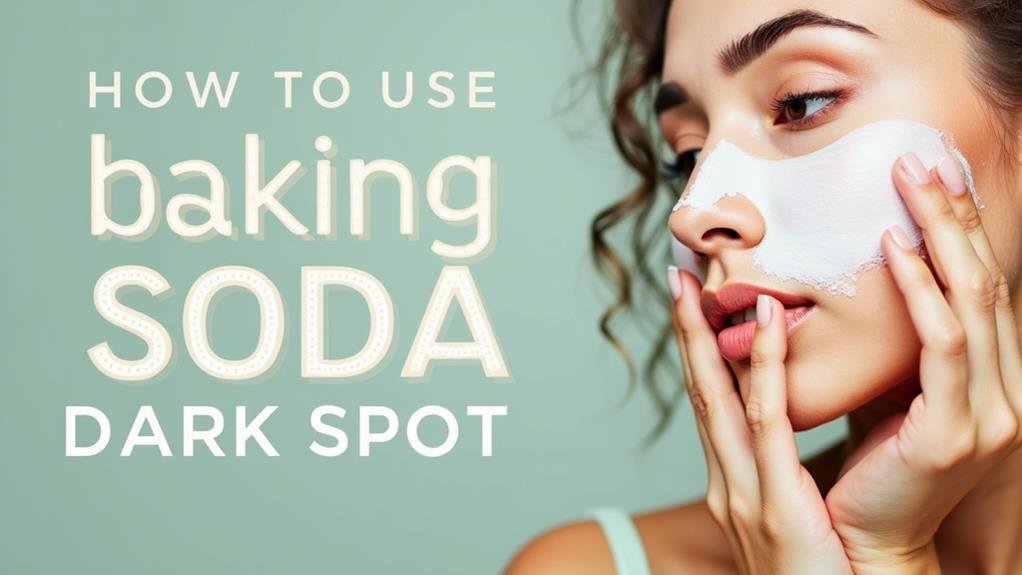If you’re looking to address dark spots, you might find that baking soda offers a simple yet effective solution. By mixing it with water, you can create a paste that targets these blemishes directly. However, it’s essential to understand how this household staple actually works and what precautions you should take to guarantee your skin remains healthy. Curious about the right methods and potential risks involved? Let’s investigate the best ways to incorporate baking soda into your skincare routine.
Overview of Dark Spots
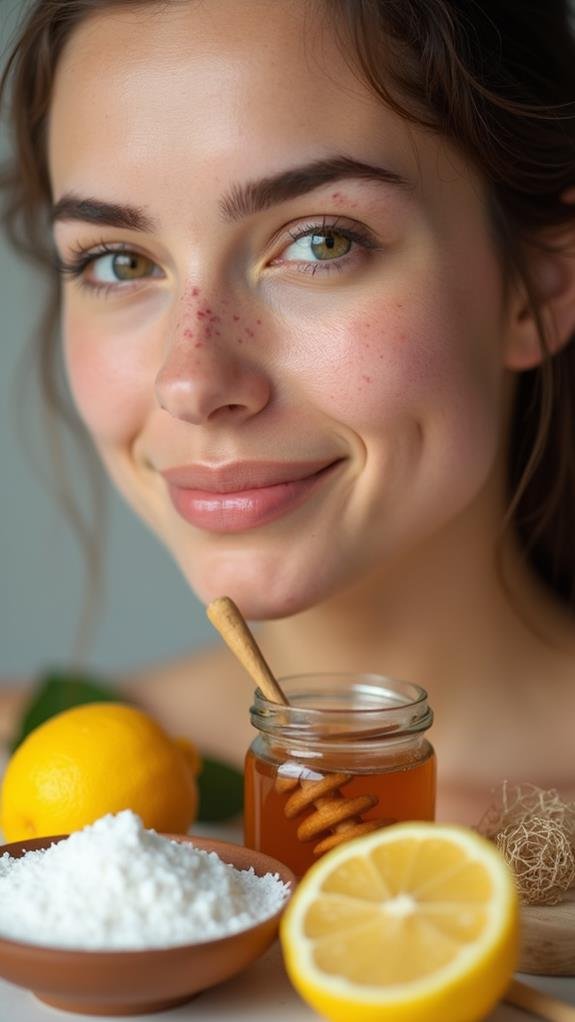
Have you ever noticed dark spots on your skin and wondered what causes them? These pesky marks, known as hyperpigmentation, can affect people of all ages and skin tones. They often develop due to sun damage, hormonal changes, or skin irritation.
If you’ve spent time in the sun without proper protection, those dark spots might be your skin’s way of reminding you to be more careful!
Medical conditions like diabetes or inflammation can also contribute to the formation of dark spots, making them a concern for many individuals.
Even certain prescription medications can lead to skin discoloration as a side effect, so it’s important to consult with a healthcare provider if you notice persistent changes.
As you age, the natural process can worsen the appearance of dark spots, leading to an uneven skin tone over time.
While you might be tempted to try home remedies, keep in mind that professional treatments like chemical peels and laser therapy generally offer quicker results.
Benefits of Baking Soda
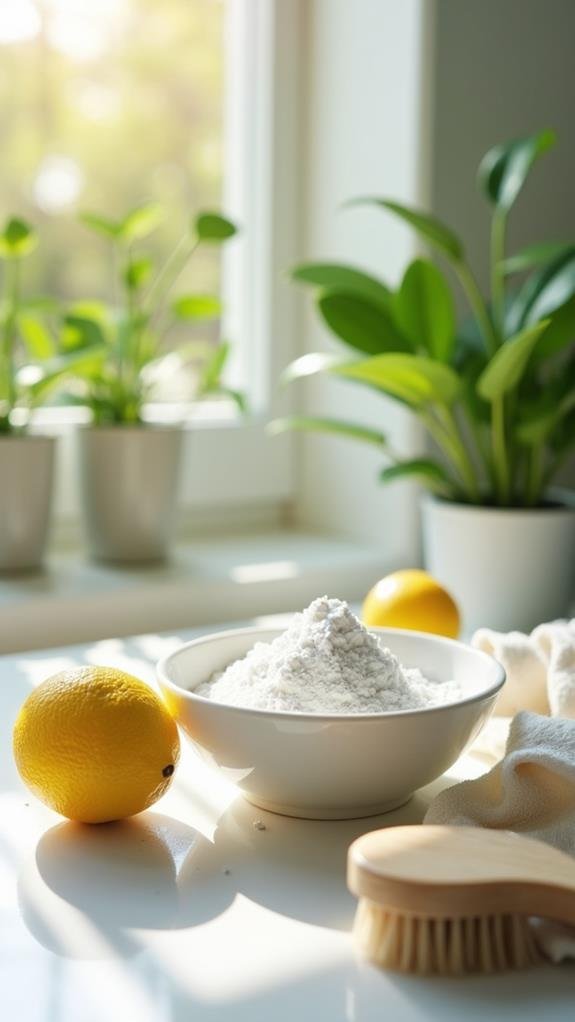
Baking soda offers a natural and effective option for addressing dark spots on your skin. Its alkaline properties help balance your skin’s pH levels, which can be particularly beneficial for treating dark spots caused by hyperpigmentation.
When you mix baking soda and water to create a paste, you can take advantage of its mild exfoliating qualities. This paste helps remove dead skin cells and promotes the growth of new ones, leading to a brighter and more even skin tone.
Additionally, baking soda has natural bleaching properties that can lighten dark spots, providing a cost-effective alternative to many commercial products. Its anti-inflammatory and antimicrobial effects can also reduce redness and irritation, contributing to overall skin health.
By incorporating baking soda into your skincare routine, you can improve the effectiveness of other skin-brightening treatments.
However, it’s essential to use baking soda cautiously, as regular use can lead to better results without irritating your skin. With these benefits in mind, you can feel more confident in your approach to tackling dark spots and achieving clearer, healthier skin.
How Baking Soda Works
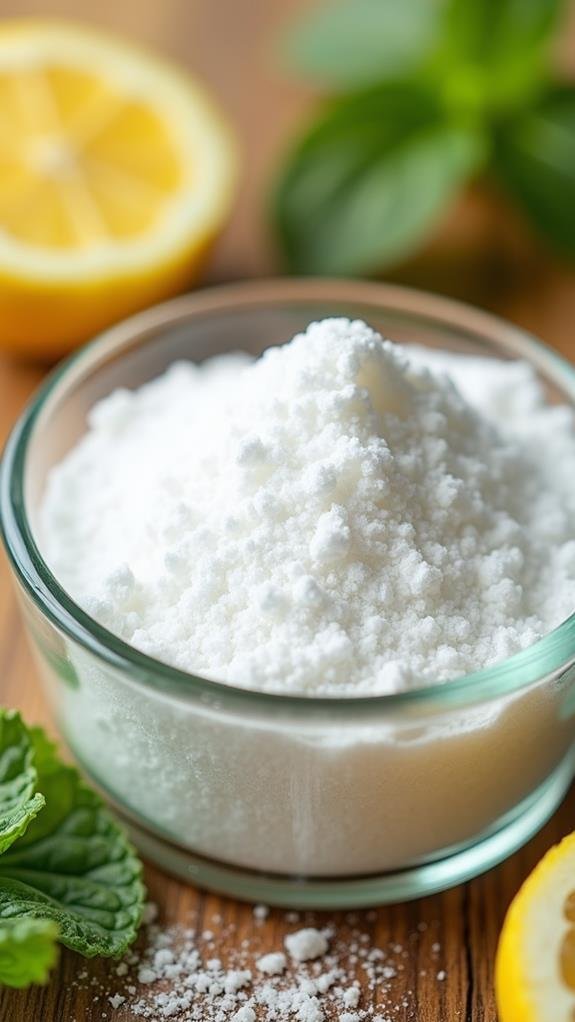
The natural properties of baking soda make it a powerful ally in the fight against dark spots. This versatile ingredient, also known as sodium bicarbonate, has alkaline properties that help balance your skin’s pH levels. When your skin’s pH is balanced, it can lead to a healthier complexion and may reduce the appearance of dark spots.
Baking soda also has mild exfoliating properties, which means it can gently remove dead skin cells. This process promotes new cell growth, helping you achieve a more even skin tone. Its gentle abrasive nature can effectively fade hyperpigmentation by sloughing off layers of skin, allowing the brighter skin beneath to shine through.
Additionally, baking soda possesses antimicrobial properties that can inhibit bacteria, which often cause skin irritation. By preventing irritation, you may reduce the risk of developing more dark spots.
While you might notice temporary lightening effects from using baking soda, remember it isn’t a substitute for professional treatments. Use it cautiously to avoid skin irritation, and always keep your skin’s unique needs in mind.
Application Methods
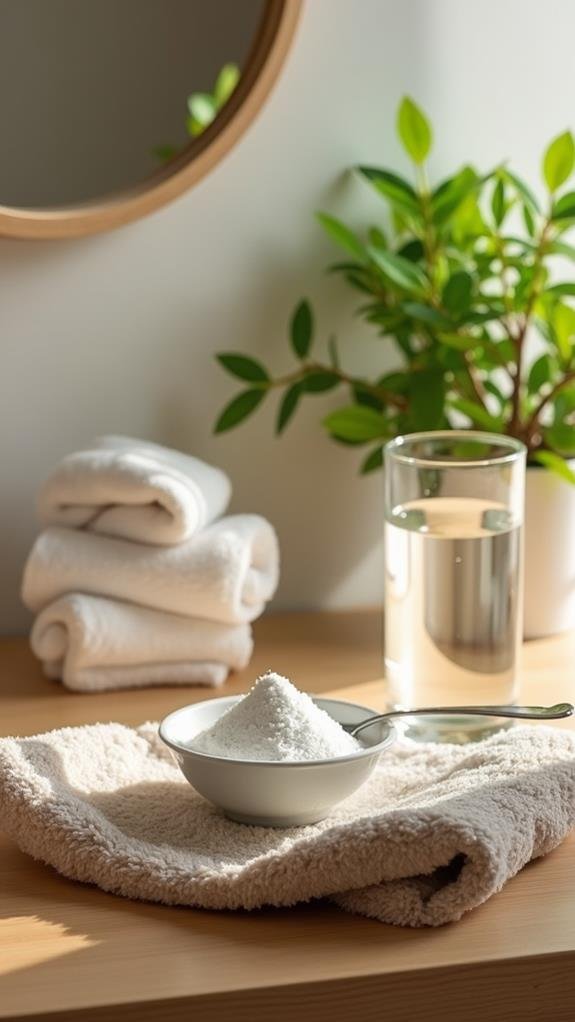
Regarding applying baking soda for dark spots effectively, there are several methods you can try. One popular way is to mix 2 teaspoons of baking soda with a small amount of water until a paste forms. You can then apply this paste directly to the dark spots for targeted treatment.
Alternatively, for a gentle exfoliation, combine 2 teaspoons of baking soda with warm water to create a paste. Apply it to your skin and leave it on for 10-15 minutes before rinsing. This method encourages cell turnover and improves skin texture.
However, it’s essential to limit these treatments to 1-3 times per week. Overusing baking soda can disrupt your skin pH and lead to irritation. After using baking soda, always follow up with a moisturizer to prevent dryness and soothe your skin.
If you have sensitive skin, keep a close eye on how your skin reacts. If you notice any irritation, stop using the treatment immediately. By following these methods, you can effectively use baking soda to help reduce dark spots while keeping your skin healthy and balanced.
Risks and Considerations
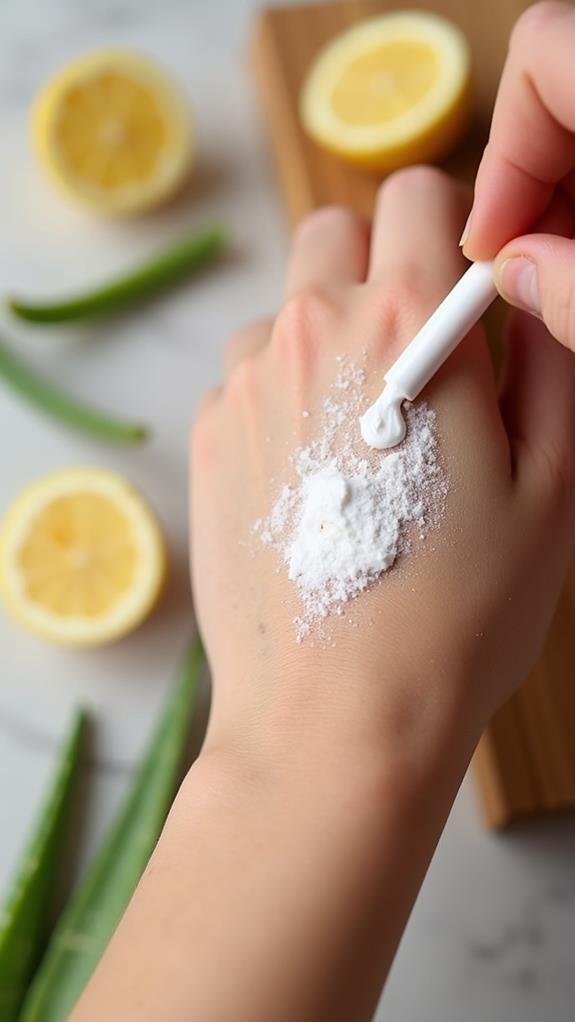
Using baking soda for dark spots can be effective, but it also comes with significant risks and considerations you should be aware of.
Baking soda has alkaline properties that can disrupt your skin’s natural pH balance, which typically ranges from 4.5 to 5.5. This disruption could lead to irritation and might even make your dark spots worse instead of better.
If you have sensitive skin, overusing baking soda can cause dryness and irritation, and even lead to early wrinkles.
It’s especially important to avoid using it on open wounds or broken skin, as this can trigger adverse reactions.
Dermatologists generally don’t recommend baking soda for treating dark spots due to these potential issues.
Other Home Remedies

Investigate various home remedies that can help lighten dark spots and improve your skin’s appearance. One popular option is lemon juice. When diluted with water, its citric acid acts as a natural bleaching agent, potentially helping to fade those pesky spots.
Just remember to use it cautiously, as it can irritate your skin if left on too long.
Another effective natural remedy is apple cider vinegar. Mixing it with water can lighten pigmentation, but be careful—apply it briefly to avoid skin damage.
Honey, known for its moisturizing and antibacterial properties, can also be beneficial. When combined with other ingredients, it helps hydrate your skin and might improve the look of dark spots.
Don’t overlook coconut oil! After trying harsher remedies, applying coconut oil can soothe and nourish your skin, keeping it moisturized.
Finally, you can mix baking soda with lemon juice for a powerful combination. This blend is popular for its potential effectiveness, though results may vary from person to person.
Each remedy has its unique benefits, so try different ones to see what works best for you!
Professional Treatment Options
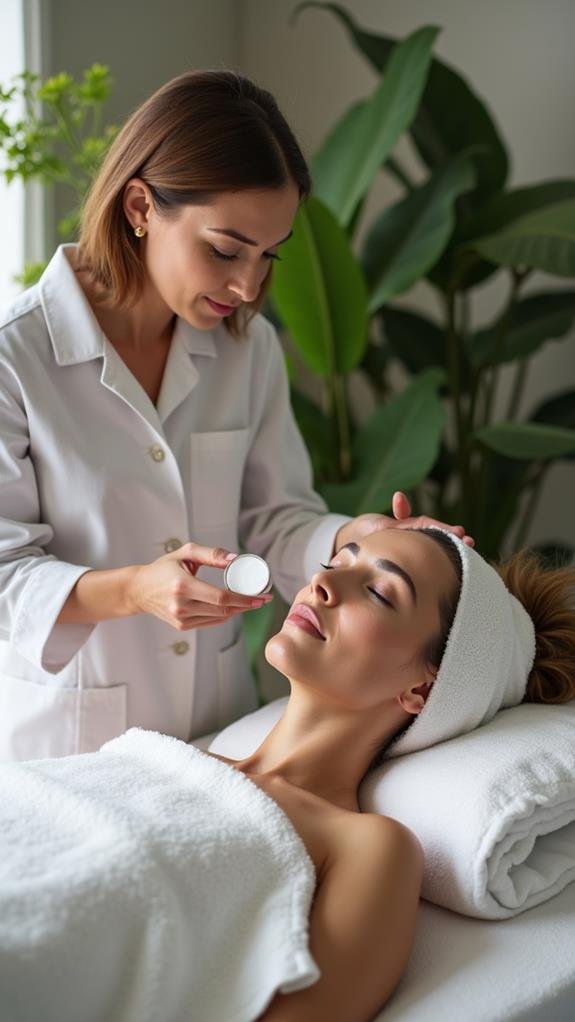
In regard to tackling dark spots effectively, professional treatment options often outperform home remedies like baking soda. If you’re struggling with hyperpigmentation, you might want to explore treatments like medical-grade chemical peels or laser skin correction.
These professional treatments can greatly fade dark spots and improve your skin’s overall texture, with noticeable results often appearing after just a few sessions.
Laser treatments specifically target dark spots and sun damage, delivering faster and more consistent outcomes compared to what you might achieve at home. You might also look into vitamin C and E treatments, as they’ve been proven to lighten hyperpigmentation while boosting collagen production, leading to healthier and more even-toned skin.
Many patients report minimal discomfort during procedures like chemical peels or laser treatments, often describing the sensations as cooling or even massage-like.
To find the best approach for your skin, it’s essential to consult with a dermatologist. They can help you create a customized treatment plan that maximizes effectiveness and safety, ensuring you get the best results possible in your battle against dark spots.
Community Experiences

Many people have shared their experiences with baking soda as a remedy for dark spots, revealing a range of outcomes. Some users have seen visible improvements in their hyperpigmentation after applying a mixture of baking soda and lemon juice. In fact, some noticed results in just one day!
Typically, you’d apply this mixture for about five minutes, but it’s essential to adjust based on your skin’s sensitivity and reactions.
Community feedback shows mixed results. While many find baking soda effective for lightening dark spots, others have experienced irritation, especially those with sensitive skin.
This highlights the importance of caution and monitoring how your skin responds. Documenting your personal results can be helpful too, as it allows you to track your progress and share insights with others trying the same remedy.
Aftercare and Maintenance
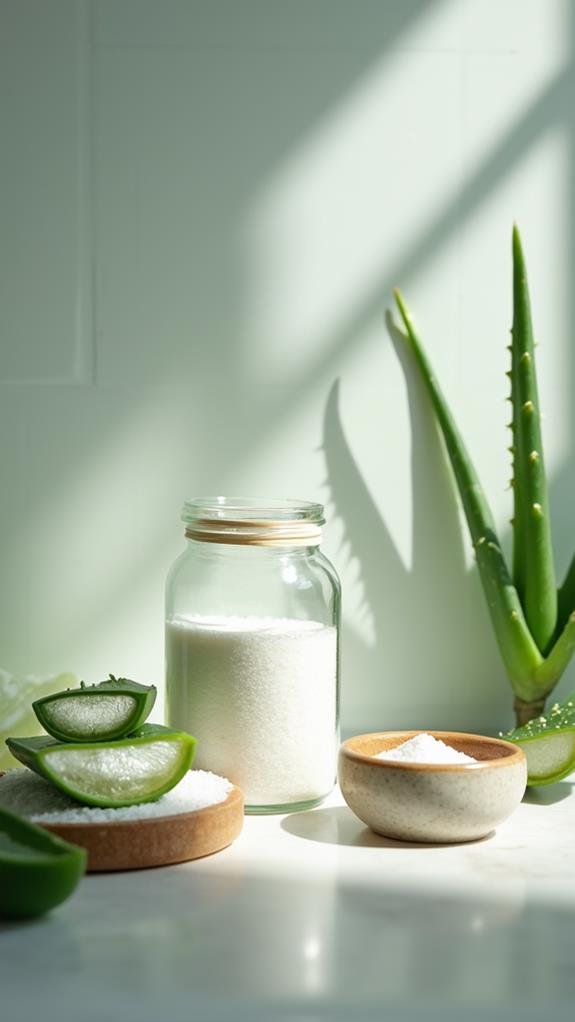
Caring for your skin after using baking soda is vital for achieving the best results and preventing irritation. First, apply a gentle, scent-free moisturizer to combat any drying effects and keep your skin hydrated. This step helps restore moisture and creates a barrier to protect your skin.
Next, avoid direct sun exposure immediately after treatment. Your skin will be more sensitive, so it’s important to use a broad-spectrum sunscreen with at least SPF 30. This protects your skin from further pigmentation and keeps those dark spots at bay.
Limit your baking soda treatments to 1-3 times per week. This helps prevent potential skin irritation or disruption of your skin’s natural pH balance. Always monitor your skin for any reactions; if you notice excessive dryness, irritation, or redness, it’s best to stop using baking soda.
Incorporate products with antioxidants, like Vitamin C, into your skincare routine. These can improve the brightening effects of baking soda on dark spots and promote a healthier complexion.
With the right aftercare, you’ll keep your skin looking bright and beautiful!
Conclusion
To sum up, using baking soda for dark spots can be a simple and effective home remedy. Just remember to mix it with water, apply it gently, and limit your treatments to avoid irritation. Always follow up with a moisturizer to keep your skin healthy. If you notice any unusual reactions, don’t hesitate to reach out to a dermatologist for advice. With patience and care, you can work towards a clearer complexion while exploring other treatment options too!

